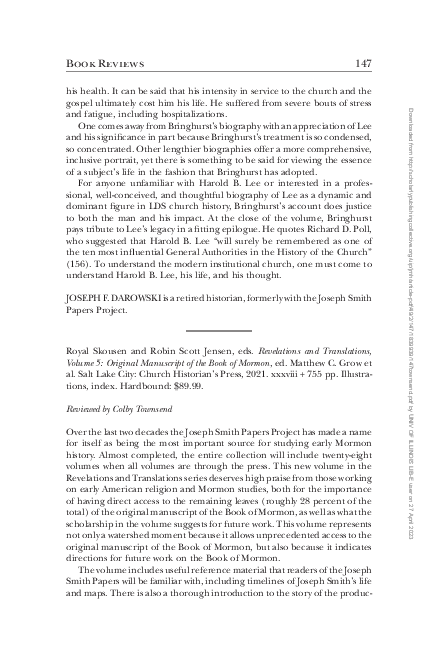Academia.edu no longer supports Internet Explorer.
To browse Academia.edu and the wider internet faster and more securely, please take a few seconds to upgrade your browser.
Review of Skousen and Jensen, eds., Revelations and Translations Vol. 5: Original Manuscript of the Book of Mormon
Review of Skousen and Jensen, eds., Revelations and Translations Vol. 5: Original Manuscript of the Book of Mormon
2023, Journal of Mormon History
Related Papers
2000 •
Dialogue: A Journal of Mormon Thought
Early Mormon Priesthood Revelations: Text, Impact, and Evolution2013 •
Introduction Joseph Smith’s revelation texts carved out a complex system of ranks, offices, jurisdictions, and judicial bodies that implicitly rejected the feminization of Protestantism, while forwarding a selective blend of biblical terminology, Book of Mormon-defined praxis, and antebellum legalisms in organizing an exclusively male “priesthood” structure.1 The purpose of this paper is to examine some early Mormon revelation texts on priesthood, to begin to understand those texts in the context of their time and place, and to brief ly observe how those texts inf luenced later Mormonism.2 The textual foundations of Mormon liturgy are not just the seed of praxis, they also created doctrine, even if some of it was temporary. Joseph Smith’s narrative of angelic visits and handbook-like revelations systematized and organized a hierarchy that gradually became self-sustaining even through the shock wave of his own death. His apostolic successors took these durable texts and fading memori...
Journal of Book of Mormon Studies volume 25 pp. 13-19.
A Book of Mormon Studies Retrospective: Twenty-Five Years of Scholarship2016 •
“A Book of Mormon Studies Prospective.” Co-authored with Mark Alan Wright, Joseph M. Spencer, and Janiece Johnson.
Nova Religio
Review: Directions for Mormon Studies in the Twenty-First Century edited by Patrick Q. Mason2018 •
1993 •
John W. Welch, ed., Reexploring the Book oj Mormon: The F.A.R.M.S. Updates. Salt Lake City: Deseret Book and F.A.R.M.S., 1992. xiv + 314 pp., with subject and scripture indexes. $9.95. Reviewed by David Rolph Seely In 1984 the Foundation for Ancient Research and Mormon Studies (F.A.R.M.S.) began publishing a one-page monthly bulletin entitled "Update," which was sent to a small audience of donors and interested researchers. The bulletin contained a timely and provocative report on some aspect of Book of Mormon studies often billed a .. a "new discovery." This volume is a collection of eighty-five short articles, including most of these bulletins, and several other simi lar studies from the F.A.R.M.S newsletters. described by the editor as "brief readable reports of new research on the Book of Mormon, aimed at a general audience" (p. xi). Indeed each article averages two-anda-half pages and is comprehensible to a general reader. Originally unsigned, thes...
Dialogue: A Journal of Mormon Thought
The Book of Mormon as a modern expansion of an ancient source1987 •
Journal of Mormon History 28.2 (Fall 2002): 192-198
Review of Terryl L. Givens, By the Hand of Mormon: The American Scripture that Launched a New World Religion2002 •
Terryl L. Givens, professor of English at the University of Richmond, Virginia, enters the stormy field of Book of Mormon studies with an examination of why generations of believers and skeptics have taken the Book of Mormon seriously. His refreshing intent is not to argue for or against the truth of the Book of Mormon or Joseph Smith's account of it. Rather, he offers the wider public an overview of the "tempestuous career" of an American scripture as a sign of young man's prophetic calling. Despite some gross errors produced by his occasional failure to investigate claims made by LDS scholars, Givens's book is not a simple repetition of the general failings of Book of Mormon studies. His willingness to discuss the nineteenth-century context as well as peculiarity of prayer in the Book of Mormon helps to keep the delicate balance he seeks and mostly maintains. As an English professor, he is at his best when dealing with linguistic and rhetorical analysis in the Book of Mormon. His forays into anthropology lack a similar rigor. He identifies the historical root of Mormon struggles with their central scripture in the mundane rhetoric of a prophet with a divine message. Givens's summary of the Book of Mormon wars in the United States make this book necessary reading for any serious student of the Book of Mormon.
RELATED PAPERS
2018 •
El-Cezeri Fen ve Mühendislik Dergisi
Site Observations on Buildings’ Performance in Hatay Province after Kahramanmaraş Earthquakes2020 •
Revista de Gestão Ambiental e Sustentabilidade
Acesso e qualidade da prestação dos serviços de saneamento básico: percepção de uma população no litoral paulistaEuropean Radiology
Effectiveness of ultrasonographic evaluation of the cranial sutures in children with suspected craniosynostosis2008 •
International Journal of Religion
White Heaven Palace and Huh Kyung Young: Political Peacemaker of a New Religion in Contemporary Korea2024 •
Linguistica Copernicana
Historia polskich nazw roślin występujących w poradniku P. Krescencjusza2015 •

 Colby Townsend
Colby Townsend